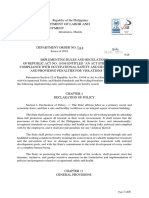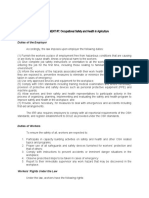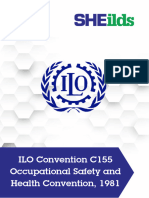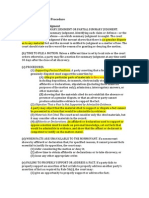NR 1 General Provisions
NR 1 General Provisions
Uploaded by
Marcos TadsioCopyright:
Available Formats
NR 1 General Provisions
NR 1 General Provisions
Uploaded by
Marcos TadsioOriginal Title
Copyright
Available Formats
Share this document
Did you find this document useful?
Is this content inappropriate?
Copyright:
Available Formats
NR 1 General Provisions
NR 1 General Provisions
Uploaded by
Marcos TadsioCopyright:
Available Formats
REGULATION 1 GENERAL PROVISIONS
1.1. The Regulations for occupational health and safety must obligatorily be followed by private and public companies and by public organs in direct and in the indirect administration, as well as organs of the Legislative and Judicial powers that have employees under the Consolidated Labor Laws CLT (corresponding initials in Portuguese). 1.1.1. The provisions contained in the Regulations apply to self-employed workers, to the entities or companies that use their services, and to the unions of the respective professional categories. 1.2. Observance of the Regulations does not release the companies from compliance with other provisions that are included in the construction codes or sanitary regulations of the States or Municipalities or others derived from Collective Labor Conventions or Agreements. 1.3. The Secretariat of Occupational Health and Safety - SSST (corresponding initials in Portuguese) is the nationwide organ that is in charge of coordinating, orienting, controlling and supervising activities related to occupational health and safety, including the National Campaign for Prevention of Occupational Accidents CANPAT (corresponding initials in Portuguese), the Program for Workers Nutrition- PAT (corresponding initials in Portuguese) and also inspection of compliance with the legal precepts and regulations on occupational health and safety in Brazil. 1.3.1. The Secretariat of Health and Safety - SSST (corresponding initials in Portuguese) is also ultimately liable for the appeals, voluntary or regular, made against decisions proffered by the Regional Labor Commissioners in matters of health and safety. 1.4. The Regional Labor Office DRT (corresponding initials in Portuguese), is the regional organ liable for executing activities related to occupational health and safety within its jurisdiction, including the National Campaign for Prevention of Work Accidents - CANPAT, the Program for Worker Nutrition- PAT and also the inspection of compliance with the legal precepts and regulations on occupational health and safety. 1.4.1. The Regional Labor Office DRT (corresponding initials in Portuguese), or the Maritime Labor Office DTM Office DRT (corresponding initials in Portuguese),, within their jurisdictions are also liable for: a) adopting the measures necessary for faithful observance of the legal precepts and regulations on occupational health and safety; b) charging the appropriate penalties for non-compliance with the legal precepts and regulations on occupational health and safety; c) halting construction, and placing embargos on establishments, service sectors, worksites, work fronts, work locations, machines and equipment; d) notifying companies, setting deadlines for elimination and/or neutralization of unsafe conditions; e) meeting legal requirements for carrying out health and safety inspections at locations where there is no occupational doctor or safety engineer registered with the Ministry of Labor. 1.5. Other Federal, State or Municipal Organs may be entitled, through an authorized agreement by the Ministry of Labor, to inspect and/or orient companies as to compliance with legal precepts and regulations on occupational health and safety. 1.6. For purposes of application of these Regulations, it is considered that: a) the employer is the individual or collective company that assumes the risks of an economic activity and hires, pays and directs the rendering of services. Professionals, charitable institutions, recreation associations or other non-profit institutions that hire workers are considered equivalent to employers;
b) the employee is the person that renders a service, that is not of an intermittent nature, to an employer under his commands and in exchange for a salary; c) a company is the establishment or set of establishments, worksite, work front, work location or others constituting an organization which is used by the employer to achieve its objectives; d) an establishment is each of the units of the company, working in different locations, such as: a factory, refinery, plant, office, store, workshop, warehouse or laboratory; e) a service sector is the smallest administrative or operational unit in the establishment; f) a worksite is the area of temporary or fixed work, where operations to support and execution of construction, demolition, or repair services are developed; g) a work front is the area of mobile and temporary work where operations to support the execution of construction, demolition or repair services are developed; h) the work location is the area where work is developed. 1.6.1. Whenever one or more companies are under the direction, control or administration of another, constituting an industrial, commercial or other kind of group, although each has its own legal identity, for the purposes of application of the Regulation, they will be held responsible together, the main company and each subsidiary. 1.6.2. For the purposes of the application of this Regulation, an engineering project, whether or not it involves a worksite or work front, shall be considered an establishment, unless a specific Regulation rules otherwise. 1.7. Be the employer liable for: a) complying with and enforcing complicity with the legal provisions on occupational health and safety; (101.001-8 / I1) b) drawing up service orders on occupational health and safety and make them known to the employees, with the objective of: (101.002-6 / I1) I preventing unsafe acts in the performance of the work; II publicizing the obligations and prohibitions that employees must know and comply with; III making it known to the to the employees that they will be subject to punishment for non-compliance with the service orders issued; IV determining the procedures that shall be adopted in case of occupational accidents and professional or occupational illnesses; V adopting the measures determined by the MTb; VI adopting measures for eliminating or neutralizing unhealthy or unsafe working conditions. c) informing the workers about: (101.003-4 / I1) I the professional risks that might arise in the work locations; II the means for preventing and limiting these risks and the measures adopted by the company; III - the results of medical exams and complementary diagnostic exams to which the employees are submitted;
IV - the results of environmental assessments made at the work locations. d) allowing workers representatives to accompany the inspection of the legal and regulatory precepts on occupational health and safety. (101.004-2 / I1) 1.8. Be the employee liable for: a) complying with the legal and regulatory provisions on occupational health and safety, including service orders issued by the employer; b) using PPE supplied by the employer; c) submitting to the medical examinations outlined in the Regulations; d) collaborating with the company in the application of the Regulations; 1.8.1. Unjustified refusal to comply with the provisions in the previous item constitutes an offence. 1.9. Non-compliance with the legal and regulatory provisions on occupational health and safety will entitle the employer to apply of the penalties set forth in the pertinent legislation. 1.10. Any doubts that might arise and cases of omission found in the execution of the Regulations will be resolved by the Secretariat of Occupational Health and Safety SSMT (corresponding initials in Portuguese),.
You might also like
- Revised Penal Code Book 1 1-113Document35 pagesRevised Penal Code Book 1 1-113Ryan Conde100% (4)
- Management of Health and Safety at Work Regulations 1999Document4 pagesManagement of Health and Safety at Work Regulations 1999RameeSahibaNo ratings yet
- DO 198 Implementing Rules and Regulations of Republic Act No - 11058 An Act Strengthening Compliance With Occupational Safety and Health Standards and Providing Penalties For Violations Thereof PDFDocument26 pagesDO 198 Implementing Rules and Regulations of Republic Act No - 11058 An Act Strengthening Compliance With Occupational Safety and Health Standards and Providing Penalties For Violations Thereof PDFAlex Felices100% (3)
- Chapter 5 - Globalization of ReligionDocument35 pagesChapter 5 - Globalization of ReligionBLACK88% (8)
- America Imagine A World Without HerDocument9 pagesAmerica Imagine A World Without Herapi-298154766No ratings yet
- Explain The Sailent Features of Contract Labour (Regulation and Abolition) Act?Document22 pagesExplain The Sailent Features of Contract Labour (Regulation and Abolition) Act?rhythmsNo ratings yet
- What Is OSHA in The Philippines?Document4 pagesWhat Is OSHA in The Philippines?Anathema Device100% (1)
- Occupational Safety Task 5Document5 pagesOccupational Safety Task 5Beth FlamsNo ratings yet
- Be It Enacted by The Senate and House of Representatives of The Philippines in Congress AssembledDocument12 pagesBe It Enacted by The Senate and House of Representatives of The Philippines in Congress AssembledBryan Paulo CatiponNo ratings yet
- Emergency/ Disaster Protocol of Government EmployeesDocument34 pagesEmergency/ Disaster Protocol of Government EmployeesBo DistNo ratings yet
- Explain and State The Purpose/s of The RA 11058? DiscussDocument3 pagesExplain and State The Purpose/s of The RA 11058? DiscussAnathema DeviceNo ratings yet
- Chapter 9. Osh LegislationDocument8 pagesChapter 9. Osh LegislationJohn lery FerrerNo ratings yet
- Chapter 9Document32 pagesChapter 9John lery FerrerNo ratings yet
- Responsibilities of Employers and EmployeesDocument3 pagesResponsibilities of Employers and EmployeespotatootamoooNo ratings yet
- Perform Tasks in Accordance With Relevent Osh Policies and ProcedureDocument15 pagesPerform Tasks in Accordance With Relevent Osh Policies and Procedurekhiluag74No ratings yet
- Be It Enacted by The Senate and House of Representatives of The Philippines in Congress AssembledDocument11 pagesBe It Enacted by The Senate and House of Representatives of The Philippines in Congress AssembledMJ PicatoNo ratings yet
- Workers Compensation: Be It Enacted by The Senate and House of Representatives of The Philippines in Congress AssembledDocument8 pagesWorkers Compensation: Be It Enacted by The Senate and House of Representatives of The Philippines in Congress Assembledabegail capistrano100% (1)
- Stiffer Fines On EstablishmentsDocument2 pagesStiffer Fines On EstablishmentsMarvin LabajoNo ratings yet
- Bosh NotesDocument35 pagesBosh NotesdaniNo ratings yet
- 01.0 Legislation and Site SafetyDocument15 pages01.0 Legislation and Site SafetyBogdan BuràNo ratings yet
- RaDocument3 pagesRaLegal AssociateNo ratings yet
- NR Um InglishDocument4 pagesNR Um InglishFelipe FormigaNo ratings yet
- Workshop TechnologyDocument145 pagesWorkshop TechnologyMike WheazzyNo ratings yet
- Presentation 1Document26 pagesPresentation 1zeeNo ratings yet
- Safety: Safety in The Petro-Chemical IndustryDocument17 pagesSafety: Safety in The Petro-Chemical IndustrysandystaysNo ratings yet
- Justification From SB 1317 and HB64Document4 pagesJustification From SB 1317 and HB64robinrubinaNo ratings yet
- ILO COnvention 155Document7 pagesILO COnvention 155Shashikala Kollipara100% (1)
- Upload 3Document2 pagesUpload 3Vincent Jon Llagas EsmeraldaNo ratings yet
- Convention C155 - Occupational Safety and Health Convention, 1981 (No. 155)Document5 pagesConvention C155 - Occupational Safety and Health Convention, 1981 (No. 155)rozarioNo ratings yet
- Share Orca - Share - Media1675308646261 - 7026753756250952374Document16 pagesShare Orca - Share - Media1675308646261 - 7026753756250952374Blve Charmie AmanteNo ratings yet
- Department of Labor and Employment: Certificate Number: AJA15-0048Document25 pagesDepartment of Labor and Employment: Certificate Number: AJA15-0048Janelle D. Puti-anNo ratings yet
- Maritime Industry PackageDocument48 pagesMaritime Industry PackageJohn Ervin AgenaNo ratings yet
- ILO C155 Occupational Health and Safety ConventionDocument9 pagesILO C155 Occupational Health and Safety ConventionAldrinNo ratings yet
- International Treaty Ilo-Convention-C155 1981 EngDocument9 pagesInternational Treaty Ilo-Convention-C155 1981 EngAlketa ZakaNo ratings yet
- IOSH Legal UpdateDocument2 pagesIOSH Legal Updateshelley3465No ratings yet
- OMN83520Document34 pagesOMN83520Vinoth SudalaiNo ratings yet
- 2 W & L - Health and Safety at Work Act HASAW 1974 ADocument28 pages2 W & L - Health and Safety at Work Act HASAW 1974 APCNo ratings yet
- RMO No. 14-2020 Re OSH v1Document14 pagesRMO No. 14-2020 Re OSH v1Cliff DaquioagNo ratings yet
- Convention C155 - Occupational Safety and Health Convention, 1981 (No. 155)Document7 pagesConvention C155 - Occupational Safety and Health Convention, 1981 (No. 155)babjihanumanthuNo ratings yet
- Chops Internal Labour LawDocument4 pagesChops Internal Labour LawommejariNo ratings yet
- Law-Course 1Document5 pagesLaw-Course 1Kabarungi RuthNo ratings yet
- Group 2 Cosh ReportDocument15 pagesGroup 2 Cosh ReportMaricca U. HagitanNo ratings yet
- ILO Convention No. 155 Occupational Safety and Health Convention, 1981Document9 pagesILO Convention No. 155 Occupational Safety and Health Convention, 1981Salman ShahzadNo ratings yet
- Bu5 R.a.11058Document36 pagesBu5 R.a.11058Monique TierraNo ratings yet
- Proposed Additional Content OSH Law 11058Document31 pagesProposed Additional Content OSH Law 11058Marlon BernardoNo ratings yet
- DO 198 - 2018 IRR of RA No. 11058Document23 pagesDO 198 - 2018 IRR of RA No. 11058willy minaNo ratings yet
- Manual For Policy and ProcedeuresDocument6 pagesManual For Policy and ProcedeuresLaksh RameshNo ratings yet
- C155 ILO Convention C155 Occupational Safety and Health Convention, 1981Document11 pagesC155 ILO Convention C155 Occupational Safety and Health Convention, 1981SheWolf DesignsNo ratings yet
- Safety Lecture DraftDocument3 pagesSafety Lecture Draftnouran.marzoukNo ratings yet
- QL S N S: Ungre S NF 4e J4ilippi eDocument17 pagesQL S N S: Ungre S NF 4e J4ilippi eReynaldo PesqueraNo ratings yet
- 04 2014 TT-BLDTBX - enDocument10 pages04 2014 TT-BLDTBX - enTON THAT HoaNo ratings yet
- Mapua University: Intramuros, Manila School of Ar - Id - Be S.Y. 2018-2019Document42 pagesMapua University: Intramuros, Manila School of Ar - Id - Be S.Y. 2018-2019Jade NepomucenoNo ratings yet
- Ra 11058Document4 pagesRa 11058alfredphilippines2002No ratings yet
- 04 2014 TT BLDTBXH EngDocument6 pages04 2014 TT BLDTBXH EngQuan Pham BaNo ratings yet
- IGC1 Element 1 (Part 2)Document3 pagesIGC1 Element 1 (Part 2)Missy Pollard100% (1)
- Ilo C 155Document11 pagesIlo C 155Munawar Sher MuhammadNo ratings yet
- 280 - C155 Occupational Safety and Health Convention (1981)Document8 pages280 - C155 Occupational Safety and Health Convention (1981)Sherin K MonNo ratings yet
- OHS Induction ManualDocument21 pagesOHS Induction ManualPrince EugoNo ratings yet
- The Management of Health and Safety at Work Regulations 1999Document6 pagesThe Management of Health and Safety at Work Regulations 1999PAUL LessiterNo ratings yet
- 360 Excavator - Safe OperationDocument21 pages360 Excavator - Safe OperationSanket Satpathy0% (2)
- C155 Occupational Safety and Health ConventionDocument8 pagesC155 Occupational Safety and Health ConventionJosiahNo ratings yet
- C155 Occupational Safety and Health ConventionDocument9 pagesC155 Occupational Safety and Health ConventionGeorge KabongahNo ratings yet
- Communiqué Du Bar Council Sur Le Rapport Lam Shang LeenDocument2 pagesCommuniqué Du Bar Council Sur Le Rapport Lam Shang LeenION NewsNo ratings yet
- United States v. Carl Tooley, II, 4th Cir. (2012)Document5 pagesUnited States v. Carl Tooley, II, 4th Cir. (2012)Scribd Government DocsNo ratings yet
- Manahan, Jr. vs. Court of AppealsDocument15 pagesManahan, Jr. vs. Court of AppealsGretel MañalacNo ratings yet
- Equality by Maya AngelouDocument9 pagesEquality by Maya AngelouryanneNo ratings yet
- Federal Rules of Civil Procedure Rule 56 HandoutDocument2 pagesFederal Rules of Civil Procedure Rule 56 HandoutRon AlbertsonNo ratings yet
- Order in The Matter of Monotype India LimitedDocument5 pagesOrder in The Matter of Monotype India LimitedShyam SunderNo ratings yet
- Dog Park Letter To Mayor CohenDocument2 pagesDog Park Letter To Mayor Cohendatkinso9057100% (2)
- Module 2. (CJS)Document9 pagesModule 2. (CJS)Gina CambonggaNo ratings yet
- People Vs ErnasDocument3 pagesPeople Vs ErnasPia SottoNo ratings yet
- Sociology CC-10 Sem-IV Social MobilityDocument3 pagesSociology CC-10 Sem-IV Social Mobilitynamamundi4No ratings yet
- The Mediation Partnership IrelandDocument9 pagesThe Mediation Partnership Irelandmediation_irelandNo ratings yet
- Labour Law-2 Rough Draft 5th SemDocument19 pagesLabour Law-2 Rough Draft 5th SemMukul Singh RathoreNo ratings yet
- Iloilo City Regulation Ordinance 2014-447Document3 pagesIloilo City Regulation Ordinance 2014-447Iloilo City CouncilNo ratings yet
- Jurisprudence: Second DivisionDocument9 pagesJurisprudence: Second DivisionZachary Philipp LimNo ratings yet
- En Banc (G.R. No. 238467. February 12, 2019) : Del Castillo, J.Document12 pagesEn Banc (G.R. No. 238467. February 12, 2019) : Del Castillo, J.Joshua Buenaobra CapispisanNo ratings yet
- Association of Southeast Asian NationsDocument2 pagesAssociation of Southeast Asian NationsNur Syahmi Za NazriNo ratings yet
- TIKLU New 3Document43 pagesTIKLU New 3Mohan HembramNo ratings yet
- Affidavit Christiane Pelchat On PolygamyDocument204 pagesAffidavit Christiane Pelchat On PolygamyborninbrooklynNo ratings yet
- Forest Law (Arun Sir)Document11 pagesForest Law (Arun Sir)ABHISHEK SAADNo ratings yet
- Agency & Partnership Syllabus 26 November 2011Document27 pagesAgency & Partnership Syllabus 26 November 2011James Franco Madarang100% (2)
- Philippine Politics and Governance: Political ScienceDocument8 pagesPhilippine Politics and Governance: Political ScienceLani Bernardo CuadraNo ratings yet
- Contemporary World Chapter 10 Global MigrationDocument60 pagesContemporary World Chapter 10 Global MigrationAlicia LizardoNo ratings yet
- 437 - A Declaration, Remonstrance, and DemandDocument7 pages437 - A Declaration, Remonstrance, and DemandDavid E Robinson100% (1)
- Marcos vs. Chief of StaffDocument4 pagesMarcos vs. Chief of StaffAdrianne BenignoNo ratings yet
- Class 9 Social Studies Sample Paper Set 11Document10 pagesClass 9 Social Studies Sample Paper Set 11Artham ResourcesNo ratings yet
- Empire State Ov MoroccoDocument7 pagesEmpire State Ov Moroccoakil kemnebi easley elNo ratings yet
- Chapter 3 Globalization and InterpolDocument31 pagesChapter 3 Globalization and Interpoleleazar alondataNo ratings yet

























































































